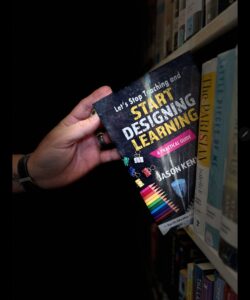For this first blog post, I want to apologize to all of the students I “taught” over the years. You may have enjoyed my classes, you may have learned some things, you may have even stopped me later at the grocery store or at the movies and told me how much you loved my class or shared some other compliment. Thank you for those words of praise, they kept me going through my years in the classroom. But looking back now, you deserved more. So please forgive me, former students. The only thing I can say about my teaching then is that I didn’t know any better.
And the truth is, I really didn’t. I went through my college education as a Secondary Education English Major in the late 90s, and do you know how many education courses I had? Two. Neither one was about pedagogy or learning strategies or evidence-based practices to use in the classroom. Oh sure, I read about Piaget and Bloom, but that was it. I did not have any formal education on how to actually “teach.” Some would say, “surely you had teaching observations and teaching practicum that prepared you.” Yes, I did spend two weeks at the beginning of a school year observing one classroom, and a semester student teaching. But again, nothing really formally educated me on what learning was or how to make it happen in a classroom. Luckily, the mentor teacher who supervised me during my student teaching was one of the most dynamic in the school. On day one, after observing her classes all day, we sat down together after the last bell in an empty classroom, and she looked at me and said, “So, what are you going to do tomorrow?” GULP. That was my initiation into education. Trial by fire to say the least. She turned me loose in her 10th grade World Literature classes for the remainder of that fall semester and by Christmas break, I was a state certified educator.
I am so thankful for my supervising teacher, her guidance and also for her trust in me to take her students from her for a semester and, for lack of a better word, experiment on them. I can’t help but think about how many other educators there are in countless classrooms today who experienced the same type of preparation as a teacher. Or even worse, those who had even less. With the ever-evaporating pool of qualified teaching applicants, many school systems are turning to less-experienced and even lesser-credentialed educators to fill vacancies in the classroom. I cannot tell you how many regional education agency trainings I have attended and heard the plight of other school systems with non-certified teachers leading their classrooms. All too often, those schools were the ones filled with students on the low end of the socio-economic scale and also the schools who needed great teachers the most.
I could spend time in this blog throwing all the articles and academia at you, the reader, which is the last thing I want to do. What I would like to do with this blog and site is provide something for veteran teachers, like myself, to take in, reflect on and rethink the way we’ve done things all these years. I also want teachers new to the profession to step into a classroom with more knowledge and tools about instruction at their disposal in their first week of teaching than I did my first ten years in the classroom. And for school leaders and administrators (I would never leave you out) perhaps provide you a differently focused lens on what to look for when observing teachers and seeking to support them in the tremendous job that they do.
So to wrap this up, I am really not writing anything that is new or cutting edge that revolutionizes education. You’ll see references to Hattie and Marzano and others sprinkled here and there. For some, I hope this site provides a foundation of practical resources for you to use to create and design your own learning in your classroom. For others, this could help clarify what to look for in a classroom that shows learning, and not just teaching, is taking place. There will be some things among these blogs you are familiar with and you will say to yourself, “Oh, I knew that; I’ve BEEN doing this.” If you are responding with that, then take what you know and pass it on to those who don’t. There will be some things you read that will cause you to pause, reflect and stretch what you believe about what you do in the classroom. To that I say, there is NOTHING wrong with that at all! Our jobs require continually looking at what we do, why we do it and if it is working. Finally, there will be those readers who may take some of this personally and not be receptive to a lot of what I am sharing. To them, I make no apologies. Education is in an ever-changing, never-ending continuum of flux. We have to reflect and change with it and do whatever it takes. That may mean giving up that tried and true teaching, so that students can try even truer learning, which means we HAVE to quit teaching, so students can learn.


